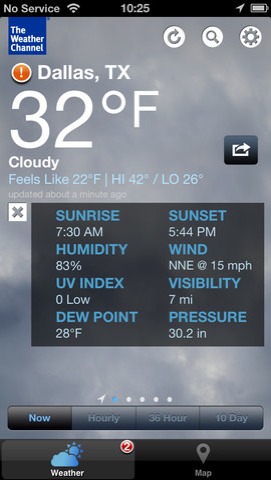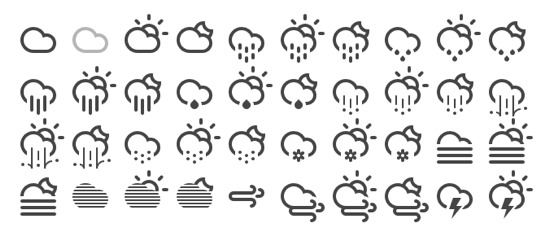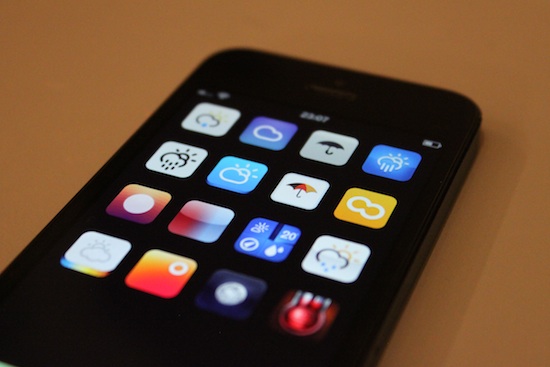Without warning, various genres of iOS apps will suddenly propagate the App Store in bursts. It happens all the time. I’m sure you all remember the Twitter app explosion; icons designed with every kind of communication metaphor imaginable came exploding onto the scene. After that, it was task management apps. In fact, there are people that still cringe at the thought of seeing another icon with a checkmark front and center. Then, personal bias begins to play up when the initial boom of these apps slows down. People pick sides, and opinions are formed and defended. Developers that are late to the game get ignored. (If you ship the 27th todo app we’ve seen this month, you’re quickly written off.) The newest genre to hit this iOS app trend is weather, which is both a good and bad phenomenon.
You’ve probably tried your fair share of weather apps, which seem to be flooding in non-stop. Mockups on Dribbble, apps in the Store available to download, web apps — complex and simple; they’re everywhere you look. But why? Why are there so many weather-related apps out there? I’m not sure we can explicitly nail that down, but we can attempt to determine a way to wade through these waters. Sick of the puns yet?
Some of these apps have been around since the iOS SDK was first made available. For instance, The Weather Channel’s app has been around for ages, so why the sudden influx of other third-party additions? It’s simple in my mind: people don’t like ugly applications.
Design matters

You could argue that TWC’s app has some of the best data out there, but that’s meaningless if it’s not properly presented. It’s just not nice to look at. Furthermore, it’s busy. Over the last handful of years, we’ve seen plenty of beautifully designed apps released. Outside was initially a hit as was WeatherSnitch. These are two examples of apps that are nicely designed but have a different set of problems, chief among them are updates and data.
Fair or not, the one fatal flaw of an iOS developer is not shipping updates. There are various reasons that the flow of updates slows to a crawl, mainly poor sales from a lack of customer interest, but your app is guaranteed to drop into an early grave if you leave a buggy mess on the table.[1]
Another huge hurdle to success with weather apps is offering accurate data. It’s the one type of app in which developers can’t afford to blow it with bad information. Outside (among others) suffered from this, so its slow death was inevitable. Therefore, if both design and data matter, what are the choices for having both, and what enables us to get there?
Use a good API, and go flat.
Climacons and APIs

Adam Whitcroft is the creator of Climacons and arguably the main conduit that spurred this explosion of “flat” weather apps. I’m not a huge fan of these, but it could be that I’m just overloaded. A simple search on Dribbble reveals boatloads of prototypes that feature this icon set. These simple, visually effective icons have literally revolutionized weather apps in the Store. While it’s easy to act annoyed by the constant influx of new apps — like I said, I’m guilty of this as well — we should probably take a step back and think it over. This is what we wanted: variety. So now that the design seems to be fixed, provided that flat UI is your thing, where’s the data coming from?
NOAA seems to be the most popular choice when it comes to choosing an API for a weather app. The government agency provides loads of information that is available commercially via an API. From what I’ve seen, the data seems relatively solid, but I assume it’s more about how it’s implemented into the app. Wunderground is also a popular choice, and searching either of these terms in the App Store will yield a hefty amount of results.
Another source that we’ve seen increasingly is from the guys at Dark Sky. We’ll get back to this app and its impressiveness in a moment, but the real key is its rock-solid data. It does one thing and does it well: precipitation. That’s it. All you get from the Dark Sky team is precipitation forecasts, and it’s damn good at it. So good, in fact, that they forecast rain down to the minute — something that I assume is extremely difficult. If you’re interested in finding out more, check out their blog.
Now that we’ve got what we think are the ingredients for a great weather app, I’ll offer you my favorites.
What I use
After a quick review of my purchased tab in the App Store, I found that I’ve tried 17 weather apps recently. Most of them were awful. Here’s my attempt to try and help you save some hard-earned cash.
One of my favorite weather apps of all time is Dark Sky, which I mentioned earlier. It’s a one-thing-well type of app. If you need to know if it’s going to rain, it tells you when, where, and for how long. It’s extraordinarily accurate, and an added bonus is its classy interface. I really can’t overstate how ridiculously accurate Dark Sky is. If it tells you rain is coming in six minutes, get an umbrella.
Another two apps I’d recommend are Today Weather and Check the Weather. Today is a gem brought to you by Savvy Apps, best known for the calendaring app, Agenda. Today presents you with a solid overview of the week ahead. You can browse hourly, daily, and weekly views, and again, the key is that it’s accurate. I really enjoy how the weekly information is presented — it’s colorful and informative. The folks of Savvy Apps have made a name for themselves by delivering solid apps that just work. Today is another example of that reliability. Check the Weather, additionally, comes to you from veteran developer David Smith. The interactions in the app are very similar to Today, although it’s important to say that CtW came first. It’s really a matter of which interface you prefer, but I can undoubtedly recommend both.
If you’re into the flat trend, we’ve got treats for you too. Conditions is an app by Jake Marsh that gives you a simple approach to weather. It’s basic and beautiful and also my favorite of the Climacons-type weather apps. Much like Dark Sky, CtW, and Today, Conditions is accurate. Honestly, it’s hard not to be when the app is this simple. If you’re looking for something that just gives you a succinct five-day forecast stripped of minute details, Conditions may be for you.
What’s to come
As I said before, it’s easy to be annoyed by the flurry of apps that come in bunches, but I say let’s embrace it. There are options, and we should appreciate that. The problem with these outbreaks is wading through the crap, and hopefully we’ve helped you do just that. We like trying apps and tossing out the junk so you don’t have to. Weather apps are no different. As the amount of developers increases, these large clusters of apps will continue to crop up. That’s not a bad thing if we allow the good stuff to float to the top. Be comfortable that we’ve got you covered.
iOS screen in header image credit to Olli Wiegner
- Don’t believe me? Check out this TechCrunch article. ↩
 twitter
twitter subscribe
subscribe tip us
tip us